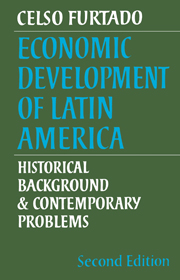Book contents
- Frontmatter
- Contents
- Tables
- Preface to the second edition
- Preface to the first edition
- Abbreviations
- Maps
- PART ONE FROM THE CONQUEST TO THE FORMATION OF NATION-STATES
- PART TWO ENTRY INTO THE SYSTEM OF INTERNATIONAL DIVISION OF LABOUR
- PART THREE THE TRADITIONAL STRUCTURAL PATTERN
- PART FOUR CHARACTERISTICS OF THE INDUSTRIALISATION PROCESS
- PART FIVE REORIENTATION OF DEVELOPMENT IN THE RECENT PERIOD
- PART SIX INTERNATIONAL RELATIONS
- PART SEVEN INTRA-REGIONAL RELATIONS
- PART EIGHT STRUCTURAL RECONSTRUCTION POLICIES
- 22 Economic planning experiments
- 23 Agrarian reforms
- 24 Economic aspects of the Cuban Revolution
- 25 Present problems and prospects
- Bibliography
- Index
24 - Economic aspects of the Cuban Revolution
Published online by Cambridge University Press: 25 January 2010
- Frontmatter
- Contents
- Tables
- Preface to the second edition
- Preface to the first edition
- Abbreviations
- Maps
- PART ONE FROM THE CONQUEST TO THE FORMATION OF NATION-STATES
- PART TWO ENTRY INTO THE SYSTEM OF INTERNATIONAL DIVISION OF LABOUR
- PART THREE THE TRADITIONAL STRUCTURAL PATTERN
- PART FOUR CHARACTERISTICS OF THE INDUSTRIALISATION PROCESS
- PART FIVE REORIENTATION OF DEVELOPMENT IN THE RECENT PERIOD
- PART SIX INTERNATIONAL RELATIONS
- PART SEVEN INTRA-REGIONAL RELATIONS
- PART EIGHT STRUCTURAL RECONSTRUCTION POLICIES
- 22 Economic planning experiments
- 23 Agrarian reforms
- 24 Economic aspects of the Cuban Revolution
- 25 Present problems and prospects
- Bibliography
- Index
Summary
Singularity of the traditional Cuban economy
Cuba displays a number of peculiarities worth analysing separately in an overall study of the Latin American framework. Along with Puerto Rico, the island remained under Spanish rule until the beginning of this century, the colonial period having lasted almost a century longer in this area than in the rest of Latin America. When the Cuban people's struggle to win their independence created impediments to US trade, the United States government used the conflict as a pretext for taking over the remnants of Spain's former Empire in the Americas and Asia. Consequently, the Cuban National State started its independent life under the occupation of United States forces. This occupation has not yet entirely come to an end - the United States government still has a base on Cuban territory - and up to 1934 it could have been extended to the whole island at any time, ‘in the interests of the Cuban people’ as adjudged by the President of the United States, in accordance with the provisions of the famous ‘Platt Amendment’. The delay of almost a century in starting the process of building a nation-state, and the particular circumstances attending its emergence under the tutelage of a powerful neighbour, make the Cuban process unique in the Latin American context. However, Cuba's singularity lies even deeper and its roots are to be found in the economic evolution of the island within the framework of the Antillean region.
- Type
- Chapter
- Information
- Economic Development of Latin AmericaHistorical Background and Contemporary Problems, pp. 278 - 295Publisher: Cambridge University PressPrint publication year: 1977



